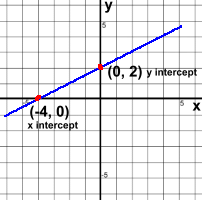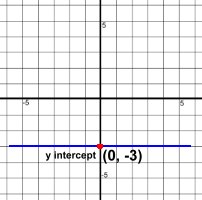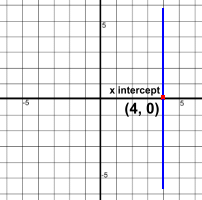|
Here is a line that crosses both axes.  It crosses the x axis at the point (-4, 0).
It crosses the x axis at the point (-4, 0).(-4, 0) is the x intercept of this line. It crosses the y axis at the point (0, 2). (0, 2) is the y intercept of the line. x intercepts always look like this: (X, 0). The y coordinate is 0. y intercepts always look like this: (0, Y). The x coordinate is 0. Lines don't always have two intercepts, but they must have one. Remember that lines extend to infinity in both directions, even though we're only showing segments of them here.
Now let's look at how to find the intercepts if you know the rule or equation that generated the points. In order to do this, you need to remember that: X intercepts are points with the y coordinate 0 Here's our first example: 4x - 5y = 10
Knowing that the x intercept is (2.5, 0) and the y intercept is (0, -2), we could plot these points to make a complete graph. We'll come back to this later. Here's a second example: y = 2x - 4
A third example: 4x + 15 = 0 Let's solve this for x first: 4x = -15 x = -3.75 We have an x coordinate. This must be the x intercept (-3.75, 0) Since there is no y in the equation, we can't find a y intercept because there isn't one. This must be a vertical line that crosses the x axis at (-3.75, 0) A final example: 2y - 8 = 0 Let's solve this for x first: 2y = 8 y = 4 We have a y coordinate. This must be the y intercept (0, 4) Since there is no x in the equation, we can't find an x intercept because there isn't one. This must be a horizontal line that crosses the y axis at (0, 4) Linear Equations | Parallel and Perpendicular | Equation Forms | Finding Equations |

